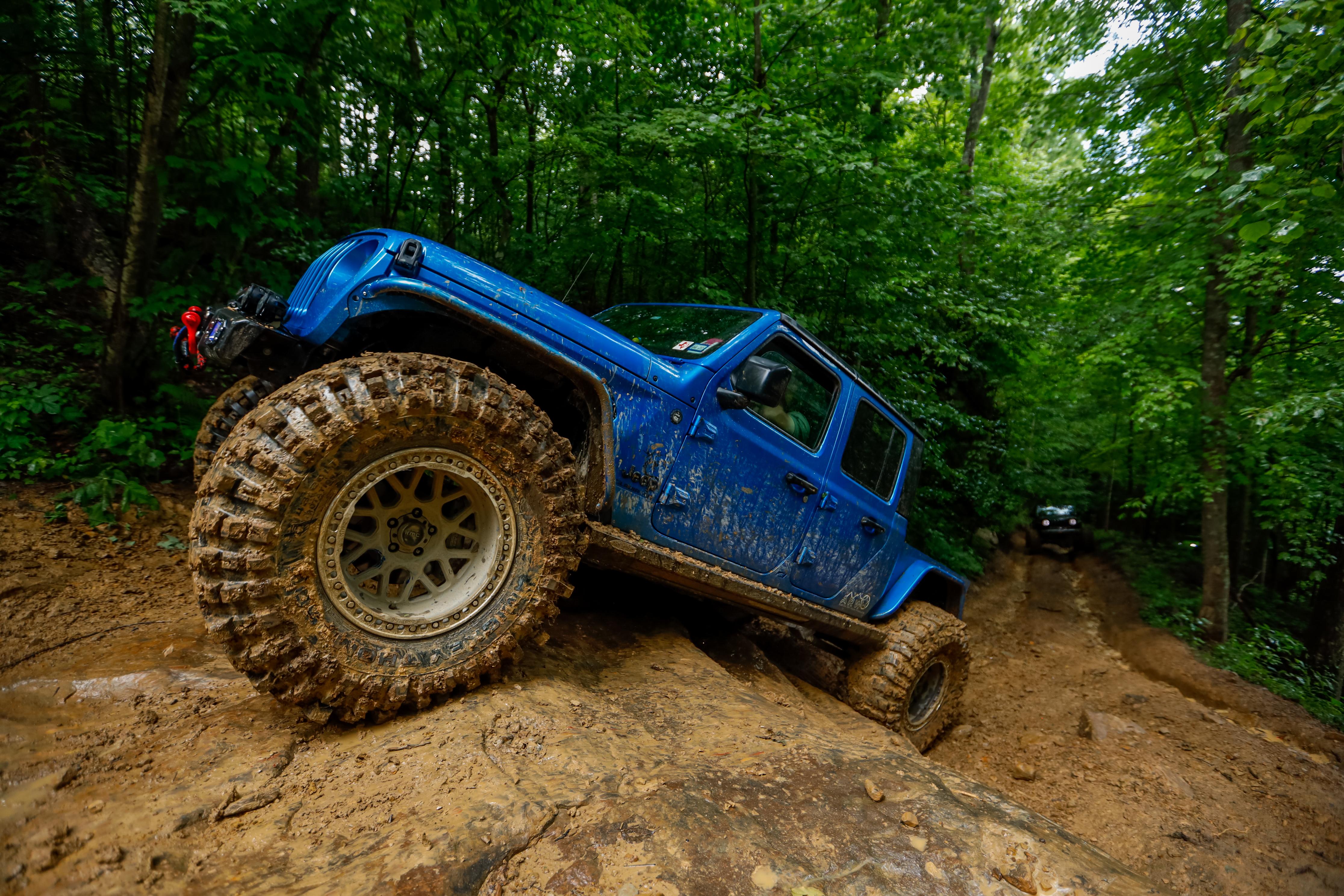Goal of this guide:
To help you understand how tires and wheels directly affect off-road performance, why traction starts with the right tire choice, and how wheel fitment determines whether your setup works smoothly or causes headaches on the trail.
Tires, Traction & Wheel Fitment
If there’s one upgrade that transforms a Jeep off-road, it’s the tires. Suspension, gearing, and lockers all matter—but without the right rubber, you won’t get far. Tires are the only point of contact between your Jeep and the terrain, and every decision about tread, size, and construction shows up immediately in how your rig drives.
- All-Terrain (A/T): Balanced for rigs that see more pavement than dirt. Quieter on the road, long-lasting tread, but limited bite in mud or slick rock.
- Mud-Terrain (M/T): Aggressive tread and open voids for maximum grip in dirt, sand, and mud. Louder on the street, faster wear, but unmatched off-road traction.
- Sticky Compounds: Soft rubber that grabs rock like glue. Perfect for hardcore crawling, but short lifespan and poor road manners mean they’re only for trailered rigs.
Unleash off-roading’s potential by mastering one of the simplest yet most effective techniques: airing down your tires. Dropping pressure transforms the way your Jeep grips sand, snow, dirt, rocks, and mud by allowing the tire to flex and mold around obstacles, creating a much larger contact patch.
- Non-Beadlock Wheels: Safe range is usually 15–18 PSI, depending on tire size and Jeep weight. Below this, you risk popping a bead.
- Beadlock Wheels: Clamp the tire bead, making it possible to run as low as 5–8 PSI in extreme terrain. That extra flexibility can mean the difference between spinning and crawling up smoothly. Even so, avoid running ultra-low pressures for extended periods.
No matter your setup, always reinflate before hitting pavement. Running highway speeds on underinflated tires builds heat, weakens sidewalls, and can cause blowouts. Carry an onboard compressor, CO₂ tank, or power inflator every trip so you can air back up before leaving the trail.
The “right” pressure isn’t a fixed number—it depends on your tire size, compound, Jeep weight, and terrain. A 37” M/T on a heavy JKU won’t behave the same as a 35” A/T on a two-door TJ. Dial in your ideal PSI through experience and adjust as needed, but always keep safety first.
Bolt Patterns (common Jeep setups):
- 5x4.5 → older Wranglers, Cherokees (XJ)
- 5x5 → JK, JL, JT
- 8x6.5 / 8x170 → one-ton axle swaps
- 17-inch wheels → The most versatile choice. Maximize sidewall flex, smoother ride, and industry standard for crawling.
- 20-inch wheels → Popular on 37s and larger. With modern tire compounds, they’re not just for show—they still perform well, especially with 40s where plenty of sidewall remains.
- Width match-up:
- 12.5” tires → best on 8.5–9” wheels
- 13.5–14.5” tires → best on 9.5–10” wheels
Too wide exposes rims and makes bead loss easier; too narrow pinches sidewalls and causes uneven wear.Hub Bore: Wheels must seat properly on the hub. Aftermarket wheels may require hub-centric rings for correct fitment.
Offset (mm) and backspacing (inches) describe wheel position relative to suspension and fenders:
- Too much positive offset (more backspacing): Wheels tuck inward, rubbing control arms, sway bars, or inner fenders.
- Too much negative offset (less backspacing): Wheels stick out aggressively. Clears suspension but increases scrub radius, adds leverage to steering, and accelerates ball joint/bearing wear.
The right balance provides clearance without stressing components or creating bump steer issues.
Your Jeep’s tires and wheels are the foundation of everything you do off-road. The right choice balances traction, durability, and safety. Whether you’re daily driving on 33s, hitting hard trails on 37s, cruising in style on 20s with 38s, or crawling extreme lines on beadlocked 42s, your setup should match your goals—and always start where the rubber meets the rocks.



